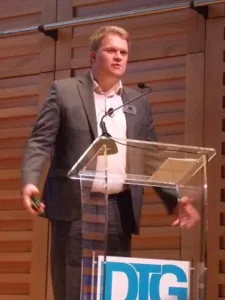Simon Gauntlett was the next speaker – he is the CTO of the DTG. “There was lots of talk about ‘beyond HD’ and future-proofing this morning”, he said, “[but] we must be careful when talking about this”.
Gauntlett echoed comments from Asda’s Andrew Uden, saying that the number of UltraHD logos in the market today causes confusion. The TV industry is looking at both 4k and 8k resolution, but these aren’t the only aspects of UltraHD. It’s also about high dynamic range (HDR), wide colour gamut (WCG), high frame rate (HFR) and immersive audio. Of these ingredients, what is the recipe that equals UltraHD TV?
The DTG brings together stakeholders to discuss this ‘recipe’. The UK UHD Forum is co-ordinating with international bodies like FAME, the DVB, ATSC, UltraHD Forum and UltraHD Alliance (these last two have an American bias).
To foster interoperability, the DTG has been running UltraHD plugfests. The first took place at the end of 2014, testing all existing UltraHD TVs, Blu-ray players and STBs. All displays showed “some form of 4k content”, said Gauntlett, but fewer than 10% could show all modes. Support for 10-bit colour and UltraHD past 30Hz was also poor.
The second plugfest, in February, looked at the HEVC codec, using a range of 2013 and 2014 TVs, as well as some prototype 2015 models. 40% of 2014 TVs and 100% of 2015 products supported HEVC. 10% of 2014 TVs only supported UltraHD at 30Hz, while 30% supported it at 50Hz or 60Hz. All of the 2015 TVs supported the format at 50Hz and 60Hz.
Problems were still observed with the TVs, however, especially in the area of of scaling; lip sync; motion judder; poor contrast; and flat colours. Main 10 support was also not universal, and only half of the models tested supported MPEG-DASH.
A third plugfest took place this month, looking at HDCP 2.2 – the DTG understands that this will be required by studios for all UltraHD content. All 2014 models had at least one A/V port supporting the standard, and most ports were HDCP-compliant on 2015 TVs. However, there was no labelling or consistency about which ports offered support. There was also little support for 6Gbps HDMI.
A plugfest to examine HDR is planned and coming, but there is no date for it yet. There are currently six different HDR proposals in the ITU. There are also questions about how the format will look on legacy displays, and whether displays will auto-detect the HDR stream to show the best image (Bob has written a Display Daily on this topic, detailing two different approaches to HDR in the broadcast market – see BBC Approach to HDR Has Advantages for Broadcasters).
Before questions, Gauntlett took the opportunity to promote a new white paper from the DTG Emerging Technology Forum, which deals with film and TV for virtual reality (we have a physical copy of this white paper and it provides some good background on the VR market and where it is headed; we will let you know when it is published online – TA).
Responding to a question from Hewlett, Gauntlett said that he doesn’t think that resolution is the ‘killer app’ for the UltraHD recipe. He believes that the exact mix will depend on the content, with HDR being important for everything and HFR for sport.

